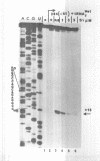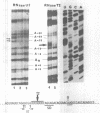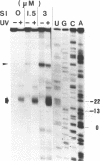Abstract
Ribosomal protein S1 is known to play an important role in translational initiation, being directly involved in recognition and binding of mRNAs by 30S ribosomal particles. Using a specially developed procedure based on efficient crosslinking of S1 to mRNA induced by UV irradiation, we have identified S1 binding sites on several phage RNAs in preinitiation complexes. Targets for S1 on Q beta and fr RNAs are localized upstream from the coat protein gene and contain oligo(U)-sequences. In the case of Q beta RNA, this S1 binding site overlaps the S-site for Q beta replicase and the site for S1 binding within a binary complex. It is reasonable that similar U-rich sequences represent S1 binding sites on bacterial mRNAs. To test this idea we have used E. coli ssb mRNA prepared in vitro with the T7 promoter/RNA polymerase system. By the methods of toeprinting, enzymatic footprinting, and UV crosslinking we have shown that binding of the ssb mRNA to 30S ribosomes is S1-dependent. The oligo(U)-sequence preceding the SD domain was found to be the target for S1. We propose that S1 binding sites, represented by pyrimidine-rich sequences upstream from the SD region, serve as determinants involved in recognition of mRNA by the ribosome.
Full text
PDF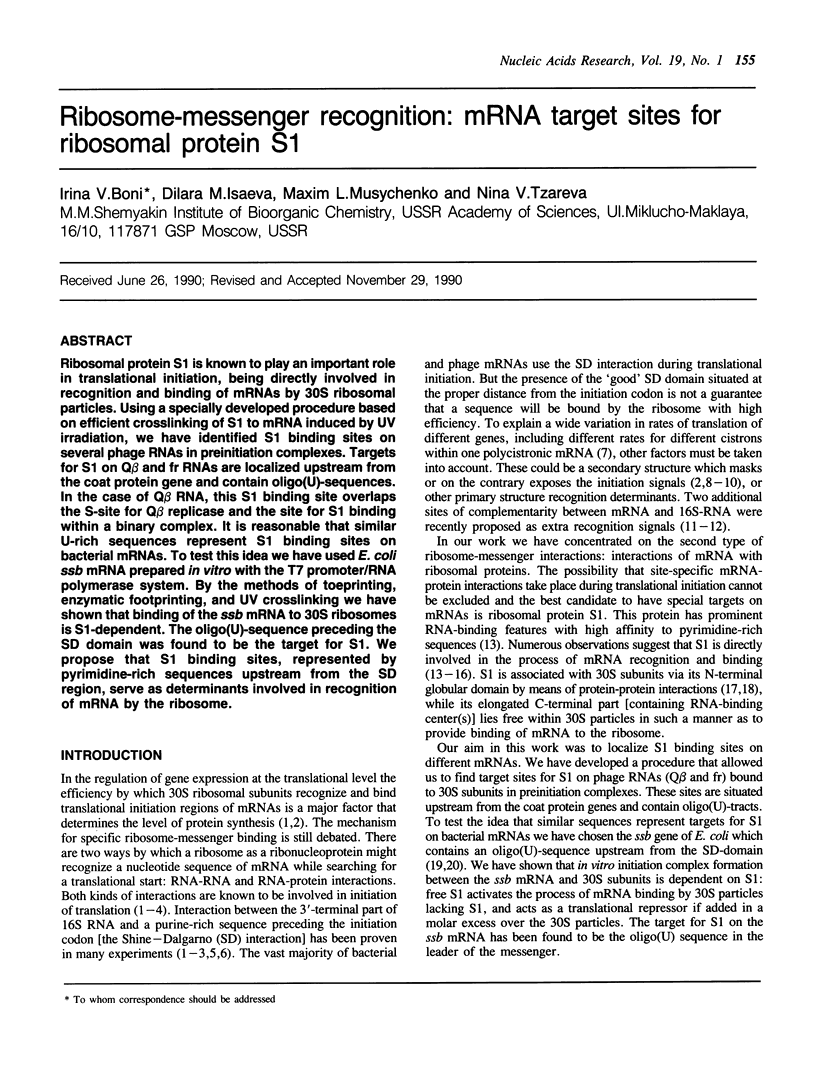
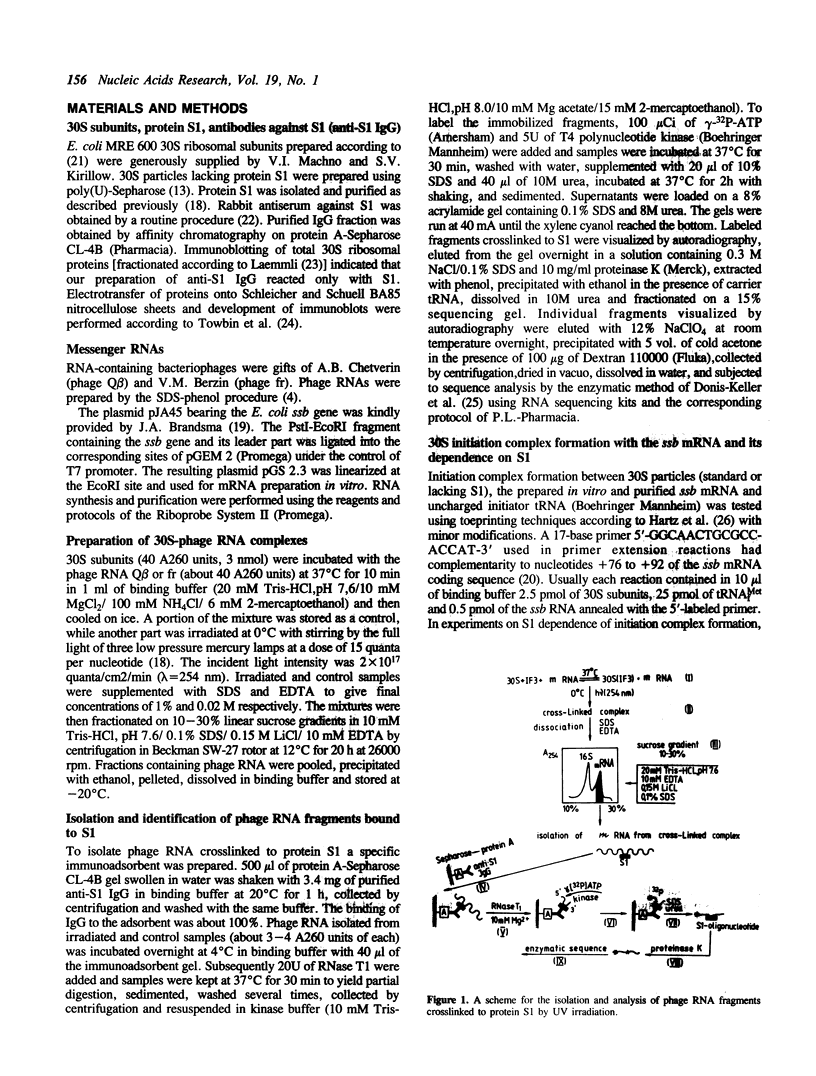
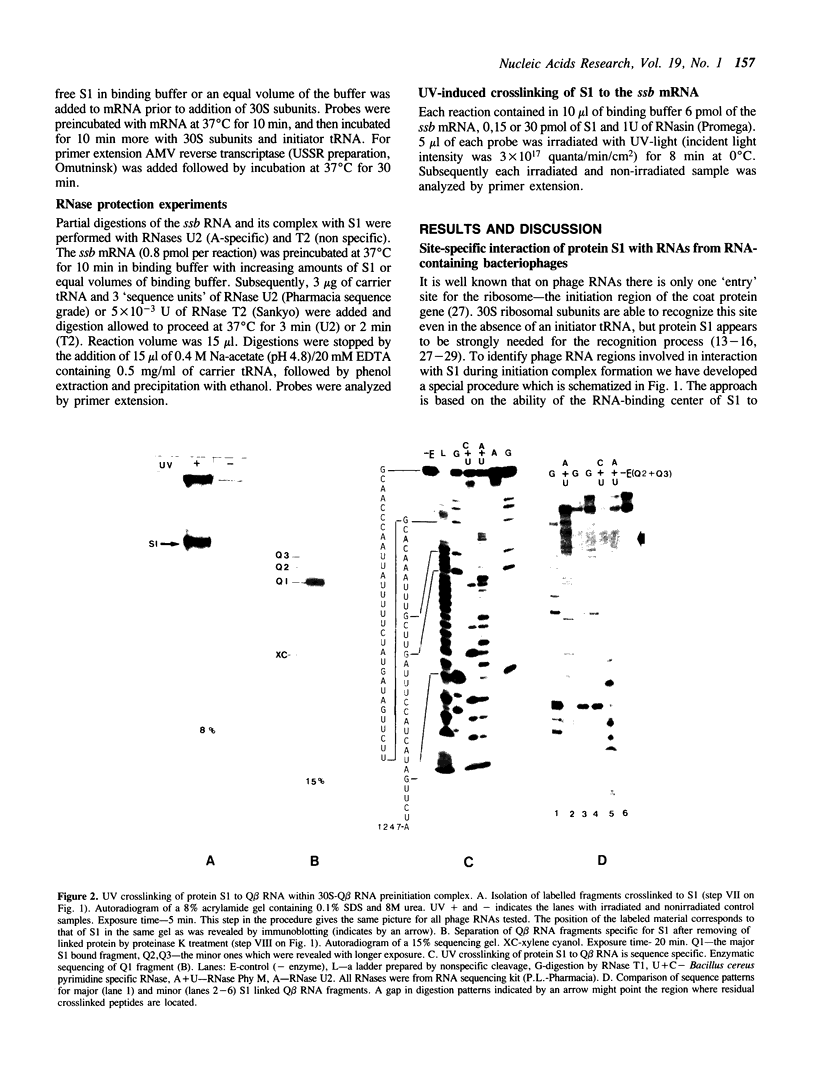
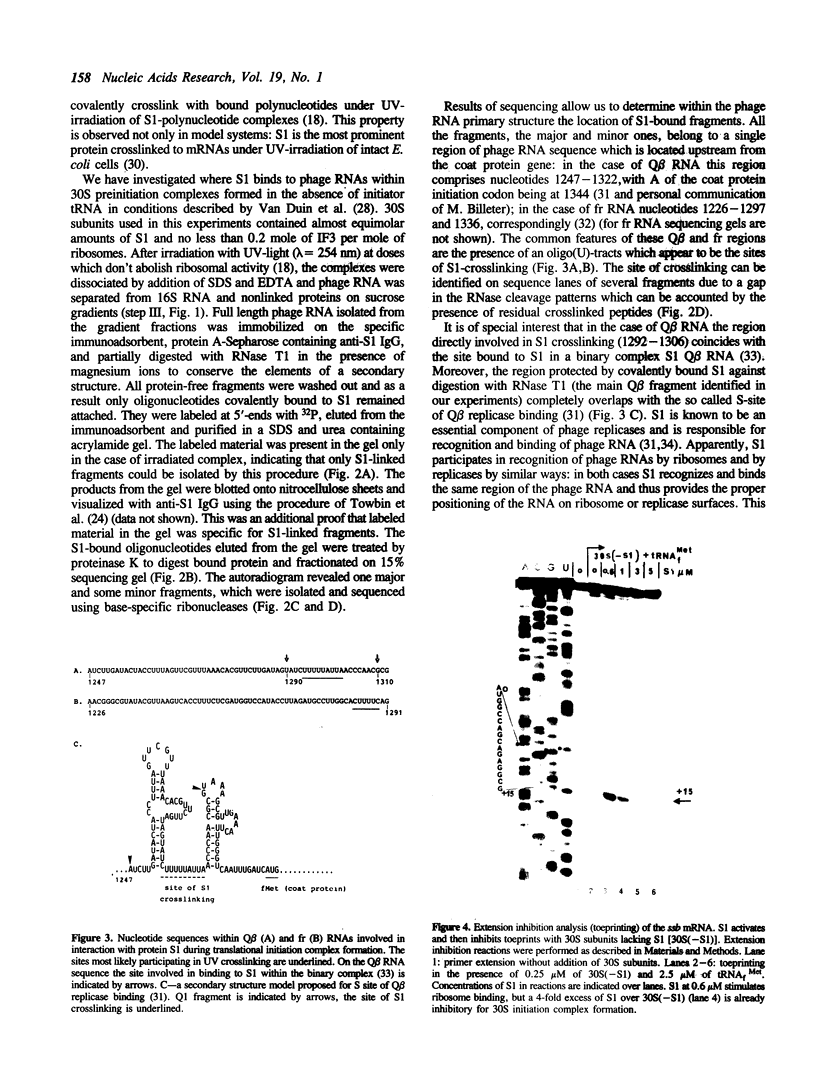
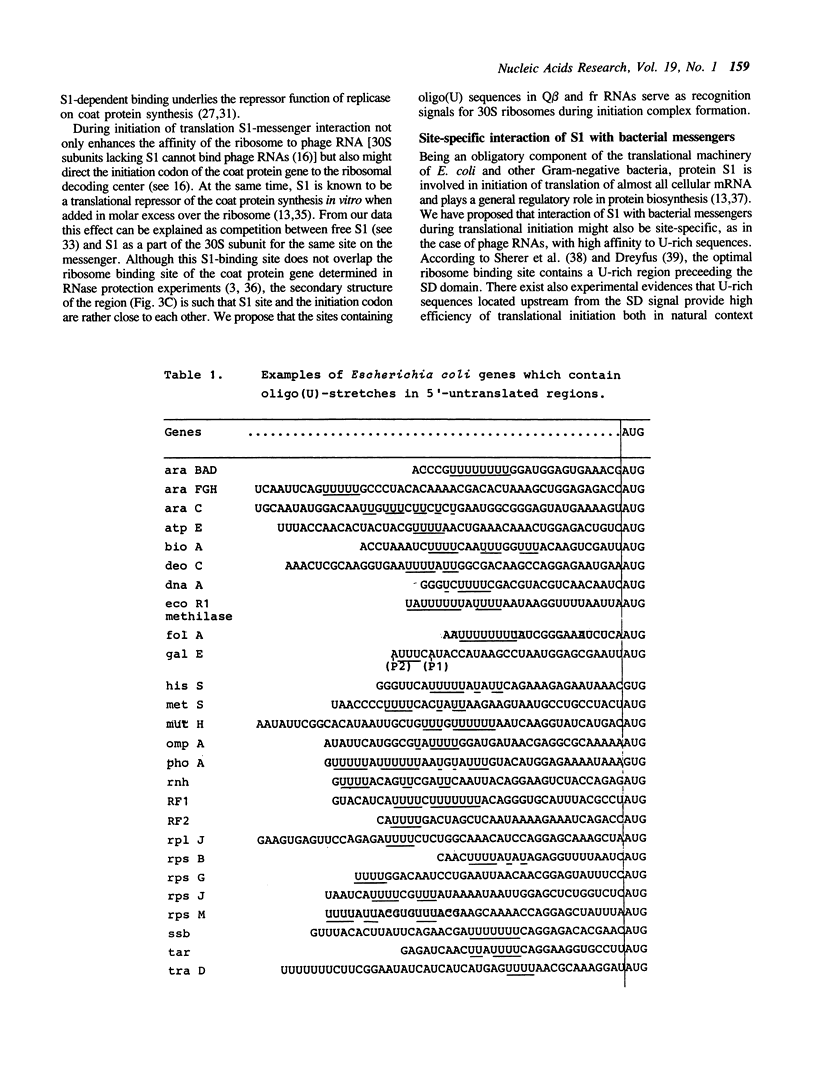
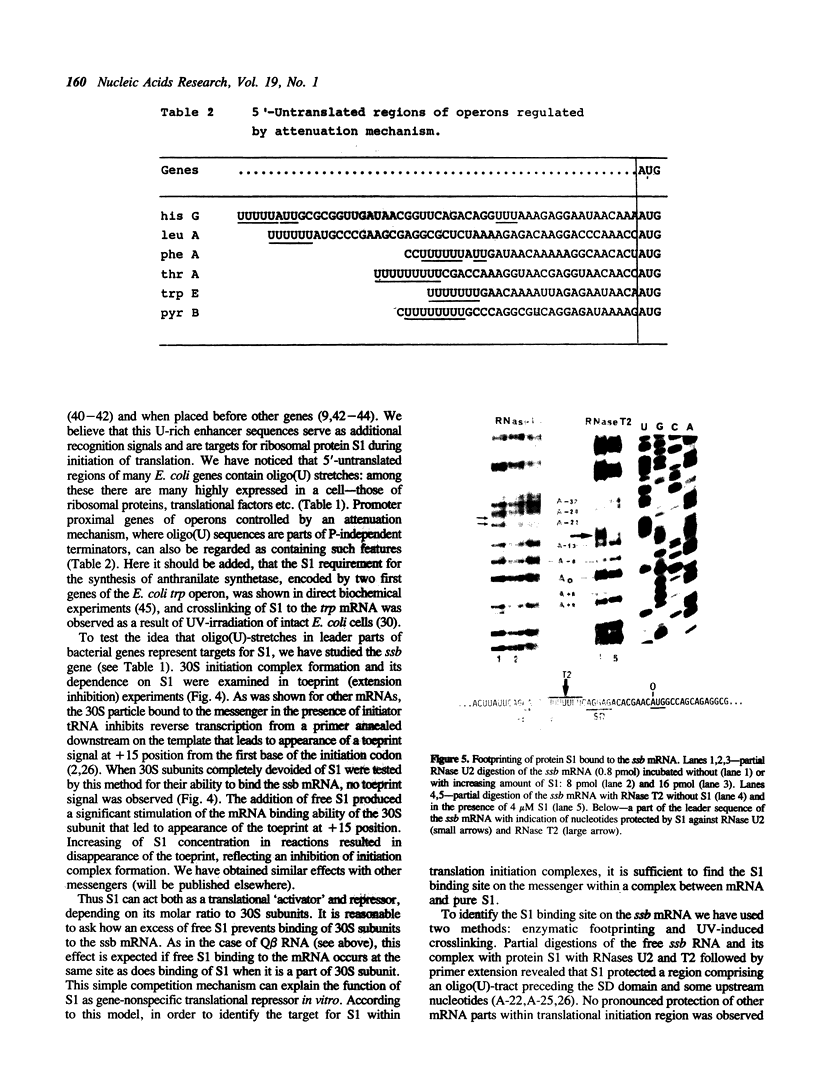
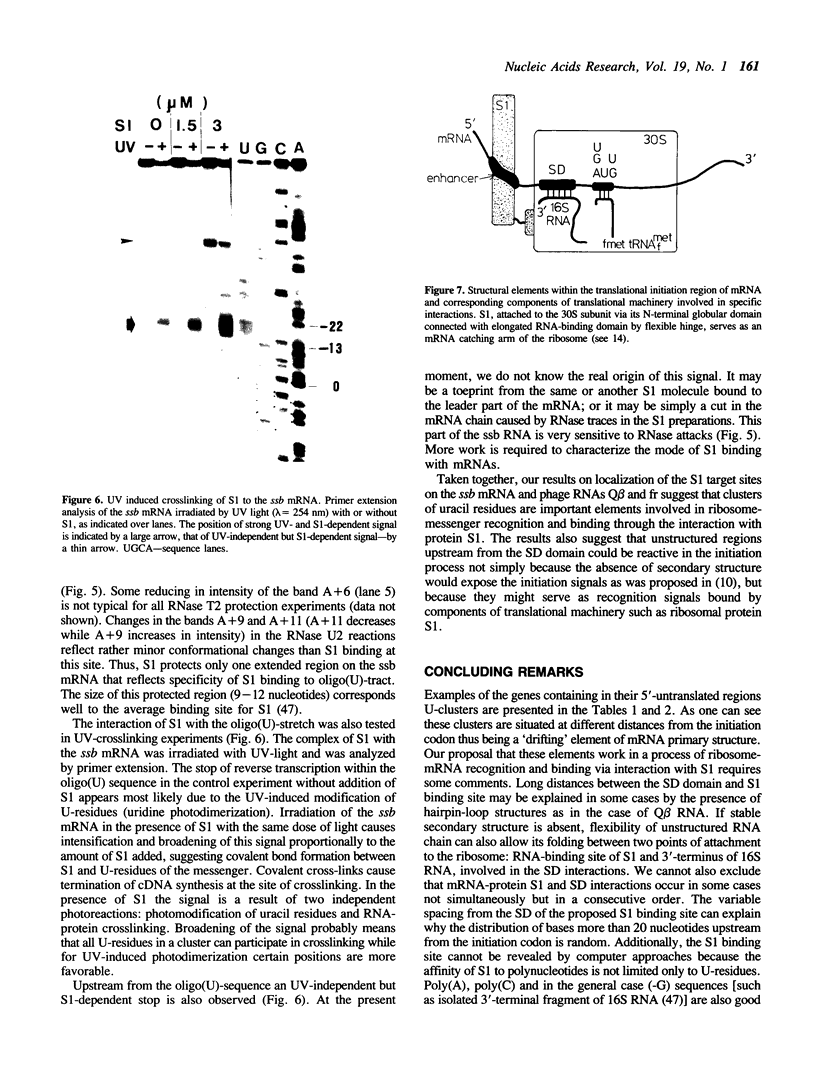
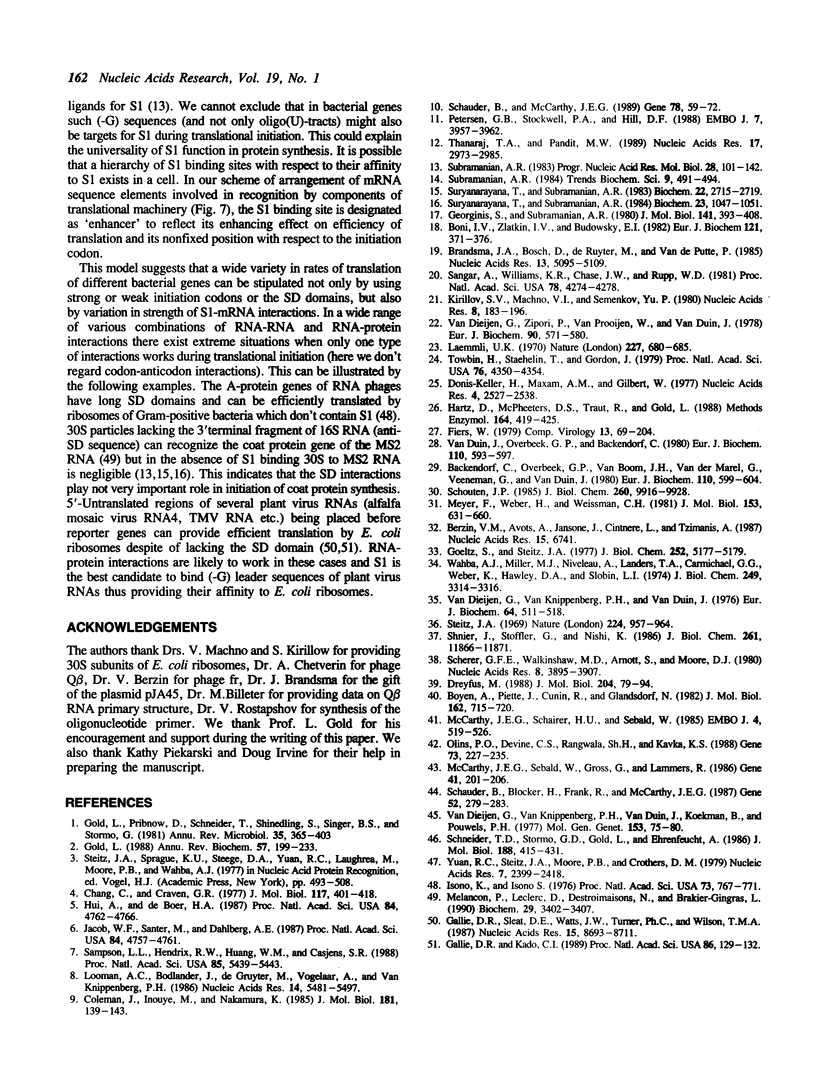
Images in this article
Selected References
These references are in PubMed. This may not be the complete list of references from this article.
- Backendorf C., Overbeek G. P., Van Boom J. H., Van Der Marel G., Veeneman G., Van Duin J. Role of 16-S RNA in ribosome messenger recognition. Eur J Biochem. 1980 Sep;110(2):599–604. doi: 10.1111/j.1432-1033.1980.tb04904.x. [DOI] [PubMed] [Google Scholar]
- Berzin V., Avots A., Jansone I., Gintnere L., Tsimanis A. Sequence of the genes coding for the A-protein and coat protein of bacteriophage fr. Nucleic Acids Res. 1987 Aug 25;15(16):6741–6741. doi: 10.1093/nar/15.16.6741. [DOI] [PMC free article] [PubMed] [Google Scholar]
- Boni I. V., Zlatkin I. V., Budowsky E. I. Ribosomal protein S1 associates with Escherichia coli ribosomal 30-S subunit by means of protein-protein interactions. Eur J Biochem. 1982 Jan;121(2):371–376. doi: 10.1111/j.1432-1033.1982.tb05796.x. [DOI] [PubMed] [Google Scholar]
- Boyen A., Piette J., Cunin R., Glansdorff N. Enhancement of translation efficiency in Escherichia coli by mutations in a proximal domain of messenger RNA. J Mol Biol. 1982 Dec 15;162(3):715–720. doi: 10.1016/0022-2836(82)90400-4. [DOI] [PubMed] [Google Scholar]
- Brandsma J. A., Bosch D., de Ruÿter M., van de Putte P. Analysis of the regulatory region of the ssb gene of Escherichia coli. Nucleic Acids Res. 1985 Jul 25;13(14):5095–5109. doi: 10.1093/nar/13.14.5095. [DOI] [PMC free article] [PubMed] [Google Scholar]
- Chang C., Craven G. R. Identification of several proteins involved in the messenger RNA binding site of the 30 S ribosome by inactivation with 2-methoxy-5-nitrotropone. J Mol Biol. 1977 Dec 5;117(2):401–418. doi: 10.1016/0022-2836(77)90135-8. [DOI] [PubMed] [Google Scholar]
- Coleman J., Inouye M., Nakamura K. Mutations upstream of the ribosome-binding site affect translational efficiency. J Mol Biol. 1985 Jan 5;181(1):139–143. doi: 10.1016/0022-2836(85)90332-8. [DOI] [PubMed] [Google Scholar]
- Donis-Keller H., Maxam A. M., Gilbert W. Mapping adenines, guanines, and pyrimidines in RNA. Nucleic Acids Res. 1977 Aug;4(8):2527–2538. doi: 10.1093/nar/4.8.2527. [DOI] [PMC free article] [PubMed] [Google Scholar]
- Dreyfus M. What constitutes the signal for the initiation of protein synthesis on Escherichia coli mRNAs? J Mol Biol. 1988 Nov 5;204(1):79–94. doi: 10.1016/0022-2836(88)90601-8. [DOI] [PubMed] [Google Scholar]
- Gallie D. R., Kado C. I. A translational enhancer derived from tobacco mosaic virus is functionally equivalent to a Shine-Dalgarno sequence. Proc Natl Acad Sci U S A. 1989 Jan;86(1):129–132. doi: 10.1073/pnas.86.1.129. [DOI] [PMC free article] [PubMed] [Google Scholar]
- Gallie D. R., Sleat D. E., Watts J. W., Turner P. C., Wilson T. M. A comparison of eukaryotic viral 5'-leader sequences as enhancers of mRNA expression in vivo. Nucleic Acids Res. 1987 Nov 11;15(21):8693–8711. doi: 10.1093/nar/15.21.8693. [DOI] [PMC free article] [PubMed] [Google Scholar]
- Giorginis S., Subramanian A. R. The major ribosome binding site of Escherichia coli ribosomal protein S1 is located in its N-terminal segment. J Mol Biol. 1980 Aug 25;141(4):393–408. doi: 10.1016/0022-2836(80)90253-3. [DOI] [PubMed] [Google Scholar]
- Goelz S., Steitz J. A. Escherichia coli ribosomal protein S1 recognizes two sites in bacteriophage Qbeta RNA. J Biol Chem. 1977 Aug 10;252(15):5177–5179. [PubMed] [Google Scholar]
- Gold L. Posttranscriptional regulatory mechanisms in Escherichia coli. Annu Rev Biochem. 1988;57:199–233. doi: 10.1146/annurev.bi.57.070188.001215. [DOI] [PubMed] [Google Scholar]
- Gold L., Pribnow D., Schneider T., Shinedling S., Singer B. S., Stormo G. Translational initiation in prokaryotes. Annu Rev Microbiol. 1981;35:365–403. doi: 10.1146/annurev.mi.35.100181.002053. [DOI] [PubMed] [Google Scholar]
- Hartz D., McPheeters D. S., Traut R., Gold L. Extension inhibition analysis of translation initiation complexes. Methods Enzymol. 1988;164:419–425. doi: 10.1016/s0076-6879(88)64058-4. [DOI] [PubMed] [Google Scholar]
- Hui A., de Boer H. A. Specialized ribosome system: preferential translation of a single mRNA species by a subpopulation of mutated ribosomes in Escherichia coli. Proc Natl Acad Sci U S A. 1987 Jul;84(14):4762–4766. doi: 10.1073/pnas.84.14.4762. [DOI] [PMC free article] [PubMed] [Google Scholar]
- Isono K., Isono S. Lack of ribosomal protein S1 in Bacillus stearothermophilus. Proc Natl Acad Sci U S A. 1976 Mar;73(3):767–770. doi: 10.1073/pnas.73.3.767. [DOI] [PMC free article] [PubMed] [Google Scholar]
- Jacob W. F., Santer M., Dahlberg A. E. A single base change in the Shine-Dalgarno region of 16S rRNA of Escherichia coli affects translation of many proteins. Proc Natl Acad Sci U S A. 1987 Jul;84(14):4757–4761. doi: 10.1073/pnas.84.14.4757. [DOI] [PMC free article] [PubMed] [Google Scholar]
- Kirillov S. V., Makhno V. I., Semenkov Y. P. Mechanism of codon-anticodon interaction in ribosomes. Direct functional evidence that isolated 30S subunits contain two codon-specific binding sites for transfer RNA. Nucleic Acids Res. 1980 Jan 11;8(1):183–196. doi: 10.1093/nar/8.1.183. [DOI] [PMC free article] [PubMed] [Google Scholar]
- Laemmli U. K. Cleavage of structural proteins during the assembly of the head of bacteriophage T4. Nature. 1970 Aug 15;227(5259):680–685. doi: 10.1038/227680a0. [DOI] [PubMed] [Google Scholar]
- Looman A. C., Bodlaender J., de Gruyter M., Vogelaar A., van Knippenberg P. H. Secondary structure as primary determinant of the efficiency of ribosomal binding sites in Escherichia coli. Nucleic Acids Res. 1986 Jul 11;14(13):5481–5497. doi: 10.1093/nar/14.13.5481. [DOI] [PMC free article] [PubMed] [Google Scholar]
- McCarthy J. E., Schairer H. U., Sebald W. Translational initiation frequency of atp genes from Escherichia coli: identification of an intercistronic sequence that enhances translation. EMBO J. 1985 Feb;4(2):519–526. doi: 10.1002/j.1460-2075.1985.tb03659.x. [DOI] [PMC free article] [PubMed] [Google Scholar]
- McCarthy J. E., Sebald W., Gross G., Lammers R. Enhancement of translational efficiency by the Escherichia coli atpE translational initiation region: its fusion with two human genes. Gene. 1986;41(2-3):201–206. doi: 10.1016/0378-1119(86)90099-5. [DOI] [PubMed] [Google Scholar]
- Melançon P., Leclerc D., Destroismaisons N., Brakier-Gingras L. The anti-Shine-Dalgarno region in Escherichia coli 16S ribosomal RNA is not essential for the correct selection of translational starts. Biochemistry. 1990 Apr 3;29(13):3402–3407. doi: 10.1021/bi00465a037. [DOI] [PubMed] [Google Scholar]
- Meyer F., Weber H., Weissmann C. Interactions of Q beta replicase with Q beta RNA. J Mol Biol. 1981 Dec 15;153(3):631–660. doi: 10.1016/0022-2836(81)90411-3. [DOI] [PubMed] [Google Scholar]
- Olins P. O., Devine C. S., Rangwala S. H., Kavka K. S. The T7 phage gene 10 leader RNA, a ribosome-binding site that dramatically enhances the expression of foreign genes in Escherichia coli. Gene. 1988 Dec 15;73(1):227–235. doi: 10.1016/0378-1119(88)90329-0. [DOI] [PubMed] [Google Scholar]
- Petersen G. B., Stockwell P. A., Hill D. F. Messenger RNA recognition in Escherichia coli: a possible second site of interaction with 16S ribosomal RNA. EMBO J. 1988 Dec 1;7(12):3957–3962. doi: 10.1002/j.1460-2075.1988.tb03282.x. [DOI] [PMC free article] [PubMed] [Google Scholar]
- Sampson L. L., Hendrix R. W., Huang W. M., Casjens S. R. Translation initiation controls the relative rates of expression of the bacteriophage lambda late genes. Proc Natl Acad Sci U S A. 1988 Aug;85(15):5439–5443. doi: 10.1073/pnas.85.15.5439. [DOI] [PMC free article] [PubMed] [Google Scholar]
- Sancar A., Williams K. R., Chase J. W., Rupp W. D. Sequences of the ssb gene and protein. Proc Natl Acad Sci U S A. 1981 Jul;78(7):4274–4278. doi: 10.1073/pnas.78.7.4274. [DOI] [PMC free article] [PubMed] [Google Scholar]
- Schauder B., Blöcker H., Frank R., McCarthy J. E. Inducible expression vectors incorporating the Escherichia coli atpE translational initiation region. Gene. 1987;52(2-3):279–283. doi: 10.1016/0378-1119(87)90054-0. [DOI] [PubMed] [Google Scholar]
- Schauder B., McCarthy J. E. The role of bases upstream of the Shine-Dalgarno region and in the coding sequence in the control of gene expression in Escherichia coli: translation and stability of mRNAs in vivo. Gene. 1989 May 15;78(1):59–72. doi: 10.1016/0378-1119(89)90314-4. [DOI] [PubMed] [Google Scholar]
- Scherer G. F., Walkinshaw M. D., Arnott S., Morré D. J. The ribosome binding sites recognized by E. coli ribosomes have regions with signal character in both the leader and protein coding segments. Nucleic Acids Res. 1980 Sep 11;8(17):3895–3907. doi: 10.1093/nar/8.17.3895. [DOI] [PMC free article] [PubMed] [Google Scholar]
- Schneider T. D., Stormo G. D., Gold L., Ehrenfeucht A. Information content of binding sites on nucleotide sequences. J Mol Biol. 1986 Apr 5;188(3):415–431. doi: 10.1016/0022-2836(86)90165-8. [DOI] [PubMed] [Google Scholar]
- Schnier J., Stöffler G., Nishi K. Deletion and insertion mutants in the structural gene for ribosomal protein S1 from Escherichia coli. J Biol Chem. 1986 Sep 5;261(25):11866–11871. [PubMed] [Google Scholar]
- Schouten J. P. Hybridization selection of nucleic acid-protein complexes. 1. Detection of proteins cross-linked to specific mRNAs and DNA sequences by irradiation of intact Escherichia coli cells with ultraviolet light. J Biol Chem. 1985 Aug 15;260(17):9916–9928. [PubMed] [Google Scholar]
- Steitz J. A. Polypeptide chain initiation: nucleotide sequences of the three ribosomal binding sites in bacteriophage R17 RNA. Nature. 1969 Dec 6;224(5223):957–964. doi: 10.1038/224957a0. [DOI] [PubMed] [Google Scholar]
- Subramanian A. R. Structure and functions of ribosomal protein S1. Prog Nucleic Acid Res Mol Biol. 1983;28:101–142. doi: 10.1016/s0079-6603(08)60085-9. [DOI] [PubMed] [Google Scholar]
- Suryanarayana T., Subramanian A. R. An essential function of ribosomal protein S1 in messenger ribonucleic acid translation. Biochemistry. 1983 May 24;22(11):2715–2719. doi: 10.1021/bi00280a020. [DOI] [PubMed] [Google Scholar]
- Suryanarayana T., Subramanian A. R. Function of the repeating homologous sequences in nucleic acid binding domain of ribosomal protein S1. Biochemistry. 1984 Mar 13;23(6):1047–1051. doi: 10.1021/bi00301a002. [DOI] [PubMed] [Google Scholar]
- Thanaraj T. A., Pandit M. W. An additional ribosome-binding site on mRNA of highly expressed genes and a bifunctional site on the colicin fragment of 16S rRNA from Escherichia coli: important determinants of the efficiency of translation-initiation. Nucleic Acids Res. 1989 Apr 25;17(8):2973–2985. doi: 10.1093/nar/17.8.2973. [DOI] [PMC free article] [PubMed] [Google Scholar]
- Towbin H., Staehelin T., Gordon J. Electrophoretic transfer of proteins from polyacrylamide gels to nitrocellulose sheets: procedure and some applications. Proc Natl Acad Sci U S A. 1979 Sep;76(9):4350–4354. doi: 10.1073/pnas.76.9.4350. [DOI] [PMC free article] [PubMed] [Google Scholar]
- Van Duin J., Overbeek G. P., Backendorf C. Functional recognition of phage RNA by 30-S ribosomal subunits in the absence of initiator tRNA. Eur J Biochem. 1980 Sep;110(2):593–597. doi: 10.1111/j.1432-1033.1980.tb04903.x. [DOI] [PubMed] [Google Scholar]
- Wahba A. J., Miller M. J., Niveleau A., Landers T. A., Carmichael G. G., Weber K., Hawley D. A., Slobin L. I. Subunit I of G beta replicase and 30 S ribosomal protein S1 of Escherichia coli. Evidence for the identity of the two proteins. J Biol Chem. 1974 May 25;249(10):3314–3316. [PubMed] [Google Scholar]
- Yuan R. C., Steitz J. A., Moore P. B., Crothers D. M. The 3' terminus of 16S rRNA: secondary structure and interaction with ribosomal protein S1. Nucleic Acids Res. 1979 Dec 20;7(8):2399–2418. doi: 10.1093/nar/7.8.2399. [DOI] [PMC free article] [PubMed] [Google Scholar]
- van Dieijen G., Zipori P., van Prooijen W., van Duin J. Involvement of ribosomal protein S1 in the assembly of the initiation complex. Eur J Biochem. 1978 Oct 16;90(3):571–580. doi: 10.1111/j.1432-1033.1978.tb12637.x. [DOI] [PubMed] [Google Scholar]
- van Dieijen G., van Knippenberg P. H., van Duin J., Koekman B., Pouwels P. H. The effect of the ribosomal protein S1 from Escherichia coli on the synthesis in vitro of bacterial-, DNA phage- and RNA phage proteins. Mol Gen Genet. 1977 May 20;153(1):75–80. doi: 10.1007/BF01035998. [DOI] [PubMed] [Google Scholar]
- van Dieijen G., van Knippenberg P. H., van Duin J. The specific role of ribosomal protein S1 in the recognition of native phage RNA. Eur J Biochem. 1976 May 1;64(2):511–518. doi: 10.1111/j.1432-1033.1976.tb10330.x. [DOI] [PubMed] [Google Scholar]




